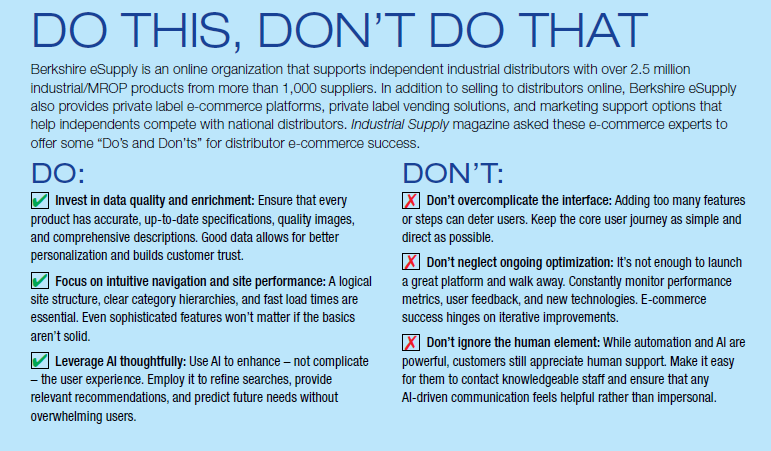 |
| istockphoto.com |
Without giving yourself nightmares.
by Kim Phelan
A host of serious considerations may not be readily understood at the beginning. “Distributors that have the attitude of ‘build it and they will come’ often find themselves disappointed,” said Marine Vienney, senior product marketing manager at KYKLO, which was recently acquired by Epicor.
 |
| Vienney |
Topping the list of big jobs – and often big headaches – in store for the distributor is managing product content for their e-commerce site. Vienney says one of the major early frustrations is the lack of quality product data from manufacturers.
“Many distributors wrongly assume their manufacturer partners will have complete and ‘e-commerce-ready’ data available simply for the asking, but rarely is that the case,” she said. “In fact, a survey conducted by KYKLO in collaboration with Distribution Strategy Group found that 90% of manufacturers have less than 50% of their U.S. price list searchable on their own websites. Many distributors try to create their own data, which sounds simple at the onset but quickly turns into a time-consuming nightmare. There are hundreds of thousands (often millions) of SKUs and assuming each takes only 10 minutes to produce, the time required turns into man-years of effort.
“Most distributors not only underestimate the resources required to produce usable content,” she continued, “but they fail to understand continuing work required to maintain their systems. Each time a product specification changes, and these happen regularly, requires yet more time to add, modify, or correct the existing SKU.”
Ryan Francis, Epicor’s senior manager, sales, adds that the volume and ongoing accuracy of products hits distributors of all sizes and verticals. “A great statement I heard from $30-billion-plus manufacturer is ‘creating content was Problem 1; getting it onto the sites of our marketplaces and distributor systems is Problem 2, and it is so much harder than we thought.”
The backdrop hanging behind product information management is the heightened customer expectation for flawless digital experience.
“The convergence of B2B and B2C experiences has become a pivotal focus,” said Jeff Botsch, industry field executive for distribution and equipment at Infor. “This evolution underscores the imperative for B2B customers to receive online services traditionally reserved for B2C interactions. Business customers now anticipate an online purchasing journey that offers advanced product configuration capabilities, enabling them to explore customizations and personalization with ease. Moreover, the option to choose from multiple units of measure must be seamlessly integrated. This streamlined self-service experience should be effortlessly accessible via both desktop and mobile platforms.
 |
| Botsch |
“The expectation extends beyond the point of purchase, with customers demanding end-to-end order transparency – from placement to delivery – without necessitating any interaction with customer service representatives,” he added. “Achieving this demands transparent integration across all systems.”
Susanne Adam, principal solution manager at SAP, says the industry is witnessing a surge in customer demands for enhanced self-service options. “Traditional web shops are evolving into comprehensive customer portals,” she added. “These portals offer personalized spaces, enhanced communication channels, and a variety of self-service options.
 |
| Adam |
“In today’s fast-paced digital world, self-service has evolved far beyond just accessing invoices and orders. Virtual Assistants are revolutionizing customer service by providing instant access to a wealth of information,” she continued. “This ranges from helping users navigate through a knowledge database, answering frequently asked questions, and even assisting in creating service tickets.”
Kristen Thom, senior vice president of customer experience at White Cup, noted, “Self-service portals that empower customers to check pricing, place orders, and track shipments independently are becoming table stakes. Customers also expect tailored recommendations and a unified experience across channels,” she added, “whether they interact online, over the phone, or through a sales rep.”
Botsch, too, suggests that e-commerce doesn’t exist alone in a bubble – rather, distributors must master the critical task of orchestrating an effective omnichannel experience, meaning orders initiated online must be flawlessly mirrored in-store. “And conversely, customers expect consistent item availability, competitive pricing, and customization options across all channels,” he said. “Additionally, providing real-time inventory visibility, including comprehensive insights into both total and store-specific stock levels, is essential for facilitating strategic in-store pickups.”
Pricing Problems
Despite e-commerce’s promise for reaching a broader audience and streamlining transactions, some distributors hesitate to create dedicated e-commerce sites when they look at the intricate and customized pricing structures associated with many of their products, according to Jayelyn Ramey, global account executive at DataXStream. “This creates a significant challenge when trying to replicate this in an e-commerce environment.” The true challenge, she says, is how to move toward e-commerce without disrupting the distributor’s B2B customer relationships, which are often built on trust and personalized service.
 |
| Ramey |
Adam agrees that displaying customer-specific pricing with acceptable performance is a recurring challenge. “Distributors frequently voice frustrations over the competitive pressures and price transparency introduced by digital marketplaces, which can erode profit margins and necessitate innovative business strategies.” In addition, she adds, complex pricing rules and the sheer volume of pricing data can strain systems, impacting the user experience.
Getting all the sundry data and customer-facing functionality in sync and up to customer standards hinges on one tool that’s probably already running in the distributor’s operations.
“The real-time, transparent integration of e-commerce platforms with existing enterprise systems like ERP is non-negotiable,” said Botsch, “which ensures the B2B with B2C experience remains seamless and consistently operational. Adam echoed that, “building highly-automated, end-to-end processes with seamless integration into ERP and other systems ensures the customer receives real-time and accurate delivery information.”
Where does AI fit into the e-commerce conversation? Adam believes it’s playing a crucial role in both customer-facing and back-end processes. “For employees, AI assists in mapping vendor product information to internal taxonomies. For customers, AI provides tools like visual search support,” she said.
 |
| Thom |
The need for in-depth e-commerce strategy cannot be underestimated. “One of the most common frustrations we hear from distributors is the disconnect between their e-commerce platform and their broader sales strategy,” said Thom. “Their customers are demanding seamless, self-service experiences, yet many distributors struggle to connect online behaviors – like product searches, abandoned carts, and browsing history – with offline interactions. This results in missed opportunities to provide personalized, proactive service.”
Setting Your Priorities
Whether you’re at the beginning of your e-commerce journey, ready to replace or upgrade an existing e-commerce system, or somewhere in the middle, priorities should be identified, and they may be different or ranked in different order from one distributor to the next. Francis recommends focusing on two main areas: (1) The customer. “Obsess over making it easier and easier for them every day,” he said. “It takes a lot to win a customer, but it takes very little to lose them.” (2) The technical aspect. “Your system should respond fast, as in 1 to 1.5 seconds,” said Francis. “So many people focus on flashy features … but lose track of the core needs of speed, security, and scalability. If you lose track of that, you are going to pay for it with major issues long term or expensive fixes.”
 |
| Francis |
Ramey added, “Distributors looking to take that first step in their e-commerce journey should not expect to move mountains overnight. Considering the often-complex nature of their product offerings and their customer relationship expectations, distributors should consider specific B2B offerings that provide the sophisticated functionality needed to sell complex products in a self-service fashion.”
Based on sources’ top recommendations, the following list of priorities will help distributors that are evaluating e-commerce systems.
1. Consistent Product Descriptions and Content Taxonomy. Clear and consistent product descriptions help customers navigate vast catalogs, says Adam, adding, “This includes high-quality images, videos, 3D models, technical specifications, and data sheets. Content managers can utilize AI tools to enrich and map vendor product data effectively.” Vienney adds that product data should look and feel the same across all brands rather than a hodge-podge of information pulled from every supplier’s website.
2. Robust Search Functionality. A powerful search engine is vital for customers to locate products quickly, Adam notes. “Features like auto-completion, filtering, and support for part numbers, SKUs, and other identifiers enhance the search experience. AI-powered search engines further improve accuracy and relevance, leading to higher customer satisfaction.”
Botsch recommends ensuring “transparency and efficiency by displaying real-time inventory levels across multiple locations, enabling customers to plan effectively and mitigate the risk of stockouts or operational delays.”
3. Advanced Configure-Price-Quote (CPQ) Capabilities. Botsch said, “Facilitate a dynamic visual selection experience that supports customer-specific pricing and generates custom quotes for large orders or special requests. This tailored approach enriches the customer journey and strengthens enterprise relationships.” Adam says distributors should also emphasize accurate product availability and pricing. “Customers need real-time information on product availability and delivery dates,” she said. “Additionally, displaying negotiated prices instead of general list prices is essential. This requires seamless integration with backend systems to ensure performance and accuracy.”
4. Comprehensive Customer Support. This includes live chat and virtual assistants, which Adam says are crucial for addressing customer inquiries and issues promptly.
5. Personalized Experiences. Utilize machine learning, says Botsch, to craft personalized, data-driven experiences that significantly enhance engagement and drive sales. “By recommending products based on past purchases and offering customized catalogs, distributors can foster deeper customer loyalty and repeat business.”
6. Efficient Order Management and Tracking. Botsch advises distributors to “implement a robust order management system that provides customers with full visibility of their order history, facilitates easy reordering, and enables real-time shipment tracking, thus enhancing post-purchase satisfaction and transparency.”
7. Empowered Self-Service Capabilities. “Enhance customer autonomy by offering features that allow independent management of accounts, payment methods, and addresses, along with easy access to invoices and order statuses,” said Botsch. “This convenience streamlines interactions and operational efficiency.” Thom added, “Customers now expect to handle common tasks themselves, like reordering, viewing account balances, and tracking shipments. A robust self-service portal that integrates with backend systems not only improves customer satisfaction but also frees up sales teams to focus on higher-value opportunities.”
8. Seamless Integration with ERP and CRM Systems. Sources concur: Integration is vital for efficient inventory management, order processing, and maintaining robust customer relationships, ultimately fostering a cohesive and agile business environment. To ensure real-time updates to product availability, pricing, and order history, distributors need an e-commerce platform that integrates tightly with their ERP.
9. Scalability for Future Growth. Thom says distributors should select an e-commerce platform that will grow with them – “for instance,” she said, “choosing a platform with an open API is a signal that the vendor is forward-thinking and the solution will seamlessly tie into other critical business systems, evolving with the distributor’s needs for years to come.”
10. Keep Effective Marketing Strategies in Mind. Although it’s not an e-commerce feature to buy, Search Engine Optimization (SEO) is a crucial consideration that will drive more organic traffic to the e-commerce site – Adam advises the use of content marketing with blogs and videos to engage the audience, as well as targeted email campaigns to keep customers informed.
 |
| istockphoto.com |
Here’s What They’ve Got
Our six sources highlighted what they’re bringing to the market today to help industrial distributors succeed with their e-commerce platforms.
Ramey at DataXStream says: DataXstream’s OMS+Portal is a B2B portal designed to meet the online commercial needs of the complex selling distributor. The OMS+Portal provides industry-specific and tailored self-service functionality to B2B customers such as: inventory visibility, order history, document visibility and tracking, credit utilization, product catalog, and variant configuration. Because OMS+Portal sits inside SAP and leverages the SAP ERP as the system of truth, transactions occur in real-time with SAP data. OMS+ provides the functionality distributors need to manage current customer expectations while driving digital transformation.
Francis at Epicor says: We are striving to really make our products systems of action – with deeper insights and more intuitive tools. With our acquisition of KYKLO (their PIM, Data Pool, and other ancillary solutions) we are geared to help distributors get content into their systems – this is our primary drive and focus today.
Vienney at KYKLO says: The standout feature and point that KYKLO is famous for is our extensive product data library. We have complete product data for hundreds of manufacturers and millions of SKUs instantly available to any authorized distributor. The data is designed with SEO that includes not just the part number or manufacturer’s name of the product but with generic names and industry jargon accounted for. This data is also designed to provide suggested add-on products, similar to leading B2C applications. Because of KYKLO’s broad experience across a wide range of computer systems, connectivity with a distributor’s ERP is easier. When combined with KYKLO’s extensive library of data (datapool), distributors can get up and running faster and with less internal effort than any e-commerce system on the market.
Botsch at Infor says: With Infor Rhythm for Commerce, Infor CPQ, Infor Augmented Intelligence Service, and their seamless connectivity with Infor CloudSuite Distribution and CloudSuite Distribution Enterprise, we are delivering unparalleled value and strategic advantages to our clients: (1) Infor Rhythm for Commerce, a sophisticated platform designed to deliver a superior online shopping experience; (2) Infor CPQ (Configure Price Quote), a visual selection tool that enables businesses to deliver tailored pricing and quoting solutions in complex sales environments. (3) Infor Augmented Intelligence Service, which blends human creativity with the prowess of artificial intelligence and machine learning. (4) Seamless Connectivity with Infor CS Distribution and Distribution Enterprise, real-time synchronization that enhances inventory visibility, optimizes stock management, and streamlines order processing, facilitating faster and more reliable service delivery.
Adam at SAP says: SAP is leveraging artificial intelligence to streamline operations and foster customer loyalty. With the "Ask the Product" tool, customers can ask specific questions about products directly on the storefront. With our use of Generative AI, customers receive instant answers about product details, materials, and warranties. Product discovery is also significantly enhanced with AI image detection, simplifying the process and delivering quick and accurate search results. AI isn't just for customers; it's a game-changer for employees too. SAP's tools can automatically extract and enrich product data, generate compelling descriptions, and create high-quality product images.
Thom at White Cup says: Our solutions connect e-commerce activity with proactive sales strategies, ensuring no revenue opportunity is missed and every customer interaction drives growth. Here’s how: (1) Seamless e-commerce integration with CRM and BI – sales reps can see which products customers are searching for, adding to carts, or buying—and use that data to follow up with targeted offers or recommendations. (2) AI-powered customer insights – with features like Buying Cycle Insights and Top Related Products, White Cup enables distributors to anticipate customer needs and make personalized product recommendations. (3) Hybrid selling enablement – our solutions support distributors’ ability to blend e-commerce with traditional sales methods. For example, by surfacing abandoned cart data in CRM, sales reps can reach out to customers directly and guide them toward completing their purchase. (4) Real-time reporting and analytics – White Cup BI provides dynamic dashboards that show distributors which e-commerce products drive the most margin, identify trends, and highlight areas for improvement, empowering leadership to make informed decisions that align with customer demands and market conditions.
 |
This article originally appeared in the January/February 2025 issue of Industrial Supply magazine. Copyright 2025, Direct Business Media.













